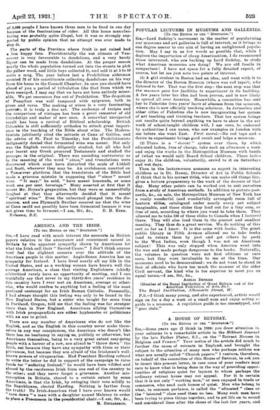POPULAR LECTURES IN MUSEUMS AND GALLERIES. (To THE EDITOR or
TEL " SPECTATOR:1 Sin,—Lord Sudeley's movement in the matter of popularizing our museums and art galleries is full of interest, as it brings us one degree nearer to our aim of having an enlightened popula- tion. May I say in as few words as- possible that, while I deplore the importation of cheap Americanism, I do recommend those interested, who are backing up Lord Sudeley, to study what American museums are doing? We are old fossils in comparison! I have not space for a fully detailed report, of course, but let me just note two points of interest.
(1) A girl student in Boston had an idea, and went with it to the director of the Boston Museum (where was red tape?), who listened to her. That was the first step: the next step was that the museum gave her facilities to experiment in its building. A few years later her idea had been proven, and is now likely to spread all over America. Meanwhile, a committee has sent her to Palestine (two years' leave of absence, from the museum, where she is now officially teaching scholars). In Jerusalem and other cities of Palestine she is now inaugurating her system of art teaching.and training teachers. That her system brings out results quite beyond anything we have to show in the art work of school-taught children will, I am sure, be endorsed by authorities I can name, who saw examples in London with me before she went East. First moral.—No red tape and a desire to experiment brings good result and helps a museum.
(2) There is a "docent" system over there, by which. educated ladies, free of charge, take each an afternoon a week and enjoy the works in the Metropolitan Museum with bands of (what we- would mill) Board School children: These ladies enjoy it; the children, voluntarily, crowd to it on Saturdays and wet days.
Then in the lecture-room someone as. export in interesting children as is Dr. Haney, Director of Art in Public Schools . (I think that is his correct title), who can make old things live, gives a lecture preparatory to the work of the docents of that day. Many other points can be worked out to suit ourselves from a study of American methods. In addition to picture post- cards, &e., on- sale, the Metropolitan Museum of New York has a really wonderful (and wonderfully arranged) room full of lantern slides, catalogued, under nearly every art subject imaginable, and those slides they lend out for a tiny sum, or free of cost, according to where you want to take- them. They allowed me to take 100 of these slides to-Canada when I lectured there. They will also lend them to the poorest and smallest meeting. They thus do a great service. We do nothing of this sort as far aa I know. It is the same with books. The great public library in Fifth Avenue allowed me to take books: (and to return. them by post and get others by post) to the West Indies, even though I was. not an American. subject! This was only stopped when America went into the war and made postage dangerous to the books. Naturally, the volumes in question were not first editions or rare ones, but they were invaluable to me at the time. Oar museums need to be-democratized: we-do not want to stand in fear of officials who have too much the manner of the older Civil servant, the kind who is too superior, to meet you on equal terms.—I am, Sir, &c., AMELIA DEM= (Member of the Royal Institution of Great Britain and of the American- Federation of Arts, die_).
The Royal Institution, Albemarle Street, W.
P.S.—I' think many young, and also experienced, artists would sign on for a day a week at a small sum and enjoy acting as guide to a museum. A regulation guide is too stereotyped, and "-goes stale."


































 Previous page
Previous page